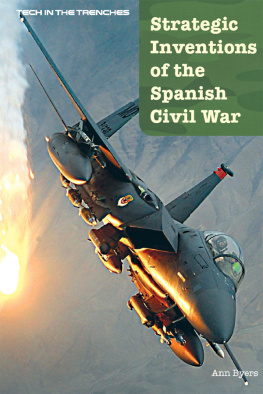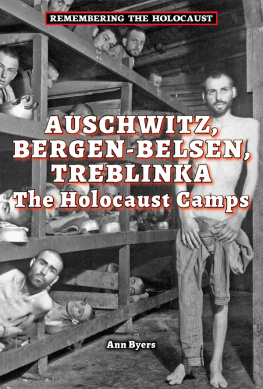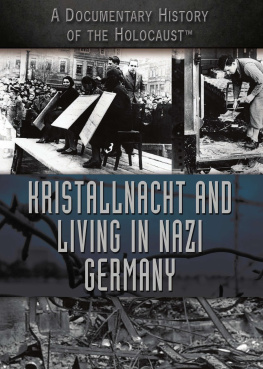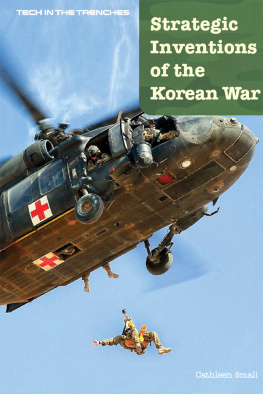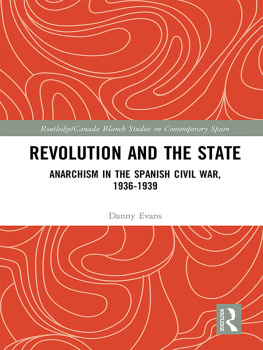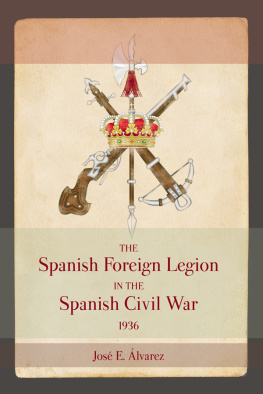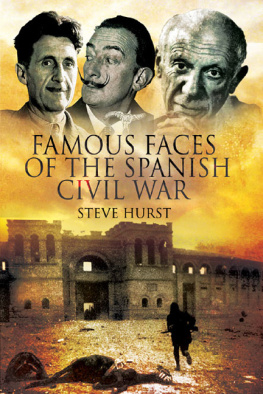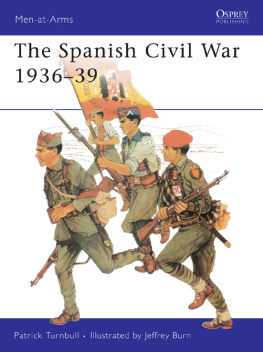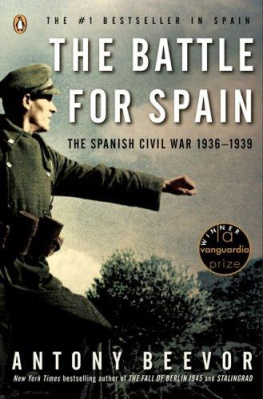Ann Byers - Strategic Inventions of the Spanish Civil War
Here you can read online Ann Byers - Strategic Inventions of the Spanish Civil War full text of the book (entire story) in english for free. Download pdf and epub, get meaning, cover and reviews about this ebook. year: 2016, publisher: Cavendish Square Publishing, LLC, genre: Politics. Description of the work, (preface) as well as reviews are available. Best literature library LitArk.com created for fans of good reading and offers a wide selection of genres:
Romance novel
Science fiction
Adventure
Detective
Science
History
Home and family
Prose
Art
Politics
Computer
Non-fiction
Religion
Business
Children
Humor
Choose a favorite category and find really read worthwhile books. Enjoy immersion in the world of imagination, feel the emotions of the characters or learn something new for yourself, make an fascinating discovery.
Strategic Inventions of the Spanish Civil War: summary, description and annotation
We offer to read an annotation, description, summary or preface (depends on what the author of the book "Strategic Inventions of the Spanish Civil War" wrote himself). If you haven't found the necessary information about the book — write in the comments, we will try to find it.
From 1936 to 1939, the Spanish Civil War ravished a nation. This was a time filled with both suffering and triumph. During it, many inventions were created, improved, or repurposed. This book describes the history behind the conflict and the key innovations that improved or impacted daily life both on and off the battlefield.
Strategic Inventions of the Spanish Civil War — read online for free the complete book (whole text) full work
Below is the text of the book, divided by pages. System saving the place of the last page read, allows you to conveniently read the book "Strategic Inventions of the Spanish Civil War" online for free, without having to search again every time where you left off. Put a bookmark, and you can go to the page where you finished reading at any time.
Font size:
Interval:
Bookmark:


Published in 2017 by Cavendish Square Publishing, LLC
243 5th Avenue, Suite 136, New York, NY 10016
Copyright 2017 by Cavendish Square Publishing, LLC
First Edition
No part of this publication may be reproduced, stored in a retrieval system, or transmitted in any form or by any meanselectronic, mechanical, photocopying, recording, or otherwisewithout the prior permission of the copyright owner. Request for permission should be addressed to Permissions, Cavendish Square Publishing, 243 5th Avenue, Suite 136, New York, NY 10016. Tel (877) 980-4450; fax (877) 980-4454.
Website: cavendishsq.com
This publication represents the opinions and views of the author based on his or her personal experience, knowledge, and research. The information in this book serves as a general guide only. The author and publisher have used their best efforts in preparing this book and disclaim liability rising directly or indirectly from the use and application of this book.
CPSIA Compliance Information: Batch #CW17CSQ
All websites were available and accurate when this book was sent to press.
Library of Congress Cataloging-in-Publication Data
Names: Byers, Ann.
Title: Strategic inventions of the Spanish Civil War / Ann Byers.
Description: New York : Cavendish Square Publishing, 2017.
| Series: Tech in the trenches | Includes index.
Identifiers: ISBN 9781502623553 (library bound) | ISBN 9781502623560 (ebook)
Subjects: LCSH: Spain--History--Civil War, 1936-1939. | Spain--History--Civil War, 1936-1939--Technology.
Classification: LCC DP269.B94 2017 | DDC 946.081--dc23
Editorial Director: David McNamara
Editor: Kristen Susienka
Copy Editor: Nathan Heidelberger
Associate Art Director: Amy Greenan
Designer: Jessica Nevins
Production Coordinator: Karol Szymczuk
Photo Researcher: J8 Media
The photographs in this book are used by permission and through the courtesy of: Cover U.S. Air Force photo/Staff Sgt. Aaron Allmon/Wikimedia Commons; p. 4 Photo 12/Contributor/Getty Images Entertainment/Getty Images; p. 11 Hulton Archive/Stringer/Getty Images Entertainment/ Getty Images; p. 14 Universal History Archive/Contributor/Getty Images Entertainment/Getty Images; p. 20 conejota (/gallery-1711990p1.html)/Shutterstock; p. 25 Mariano Benlliure y Gil/ Wikimedia Commons; p. 28 World History Archive/Alamy Stock Photo; p. 30 Phil Crean A/ Alamy Stock Photo; p. 34 NordNordWest/Modifications by user: Sting, Grandiose/Wikimedia Commons; p. 39 ullstein bild/Contributor/Getty Images Entertainment/Getty Images; p. 40 Universal History Archive/Contributor/Getty Images Entertainment/Getty Images; p. 44 () (. public domain), ./Wikimedia Commons; p. 44 Flavio Mucia (AMB Brescia)/Wikimedia Commons; p. 49 http://www-af.mil (PD-USGov-Military-Air Force)/Wikimedia Commons; p. 53 ullstein bild/Contributor/Getty Images Entertainment/Getty Images; p. 54 Mikhail Koltsov/Wikimedia Commons; p. 61 Daily Herald Archive/Contributor/ Getty Images Entertainment/Getty Images; p. 64 El noi de la garriga/Wikimedia Commons; p. 72 World History Archive/Alamy Stock Photo; p. 74 Sueddeutsche Zeitung Photo/Alamy Stock Photo; p. 81 World History Archives/Alamy Stock Photo; p. 83 Sueddeutsche Zeitung Photo/ Alamy Stock Photo; p. 86 Fine Art/Contributor/Getty Images Entertainment/Getty Images; p. 88 SeM/Contributor/Getty Images Entertainment/Getty Images; p. 93 Fox Photos/Stringer/ Getty Images Entertainment/Getty Images; p. 97 AFP/Stringer/Getty Images Entertainment/ Getty Images; BRU GARCIA/Stringer/Getty Images Entertainment/Getty Images.
Printed in the United States of America
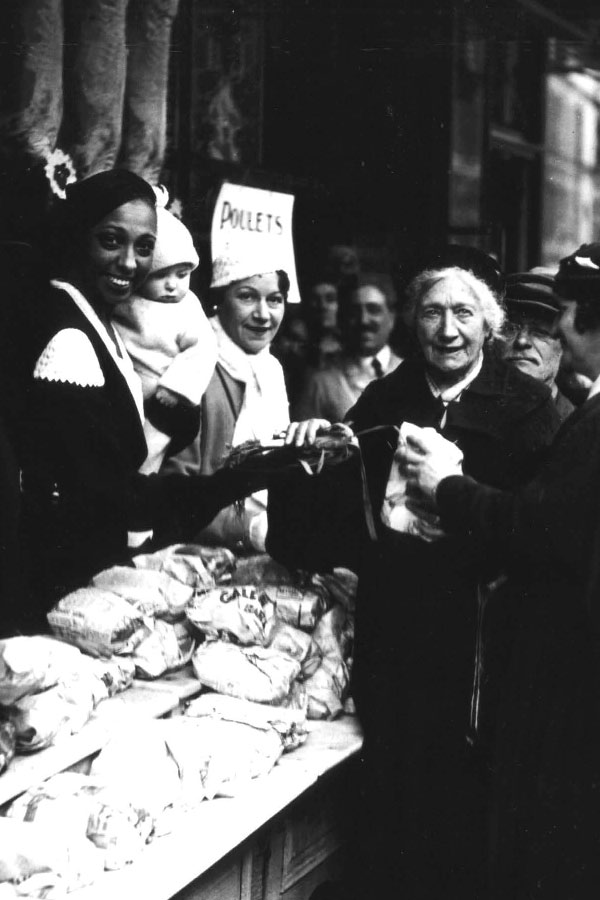
French men and women line up to receive food in 1932, during the Great Depression. The woman helping distribute the packages is Josephine Baker, an Americanborn singer and dancer extremely popular in France.
INTRODUCTION
Europe Between the Wars
T he 1920s and 1930s were difficult everywhere, but especially in Europe. The Great War, which later became known as World War I, ended in 1918, leaving destruction, disillusionment, and chaos in its wake. It had erased or moved national borders, emptied treasuries, and practically wiped out a generation of men. Between the two world wars, Europe was awash in political, economic, and social turmoil.
POLITICAL UPHEAVAL
After the Great War, four empires that had dominated the continent for centuries were no more. When Germany lost the war, the emperor, Kaiser Wilhelm II, gave up his throne, and the winners took bits of Germanys territory for themselves. A large chunk was cut away and given to Poland.
The massive Austro-Hungarian Empire had splintered into several smaller nations in the waning days of the war. Czechoslovakia and Poland broke away and became sovereign states. Slovenia, Bosnia, and Croatia declared themselves independent of the empire and soon merged with Serbia and other small groups to form Yugoslavia. Hungary and Austria, each reduced to a fraction of its former size, were divided into two separate countries.
To the east, Russia was in the throes of revolution and civil war. Territories on the northwestern edge of the vast Russian Empire Finland, Estonia, Latvia, and Lithuaniapulled away. In the southwest, fighting raged in Turkey, Romania, Ukraine, Belarus, Armenia, and other areas.
The Ottoman Empire, which once stretched across the Middle East, over northern Africa, and into eastern Europe, had begun to disintegrate long before the war. The weakened empire allied itself with Germany and thus was on the losing side. Turkey won its independence, but England and France took over the rest of the empire and divided it between them, governing the different parts like colonies.
When the map of Europe was redrawn, some of the boundary lines did not make sense. People who felt they belonged together found themselves in different countries. Millions of Hungarians were now in Slovenia, Romania, and Yugoslavia. German-speaking people were scattered among several of the new states. New borders separated tribal groups throughout the Middle East. Many people became minorities overnight in what had been their own lands.
The nations that emerged from the shambles of World War I had been monarchies. Whether the ruler was called a king, a kaiser, a czar, or an emperor, he had absolute control. The common people did not vote; decisions were made by the monarch and a small group of nobles. In the new order, there would be no kings to tell the people what to do, to settle disputes, to build roads and bridges, and to keep them safe. Without any experience in democracy, the people would have to figure out how to govern themselves. This made the interwar period a time of political floundering for much of Europe.
ECONOMIC RUIN
The political crisis was made worse by economic disaster. The war had cost more than $200 billion, money spent on tanks, bombs, and other weaponry that was now utterly destroyed or no longer of any use. The harsh terms of the Treaty of Versailles saddled Germany with a crippling debt. Nationswinners and losers alikewere not merely bankrupt; they owed huge sums. Some of the money was owed to their citizens, who had bought bonds to finance the war. Much was owed to the United States.
The governments did not have the means to repay the massive amounts they had borrowed. Manufacturing, trade, and even agriculture had been disrupted by the fighting and could not be restored easily. The war had claimed the lives of nine million servicemen and five million civilians, people who would not return to the factories and the fields. In the last year of the conflict and for two full years after, one of the worst flu epidemics in history swept the entire globe, killing more than fifty million and crushing what little economic life there was.
Font size:
Interval:
Bookmark:
Similar books «Strategic Inventions of the Spanish Civil War»
Look at similar books to Strategic Inventions of the Spanish Civil War. We have selected literature similar in name and meaning in the hope of providing readers with more options to find new, interesting, not yet read works.
Discussion, reviews of the book Strategic Inventions of the Spanish Civil War and just readers' own opinions. Leave your comments, write what you think about the work, its meaning or the main characters. Specify what exactly you liked and what you didn't like, and why you think so.

